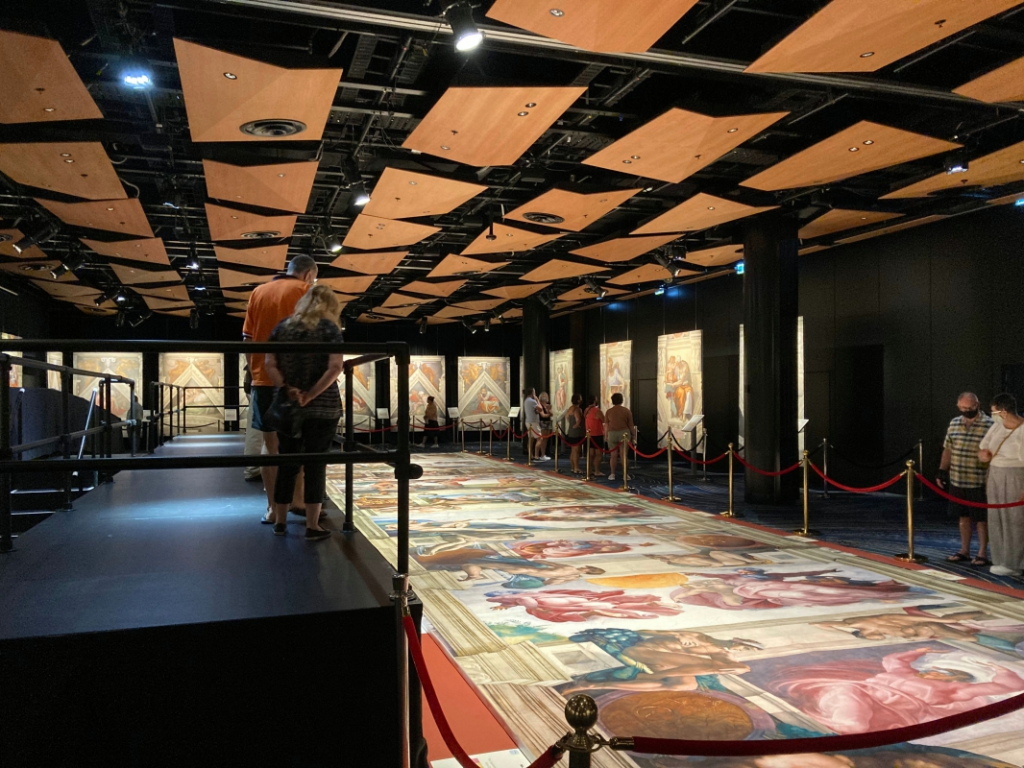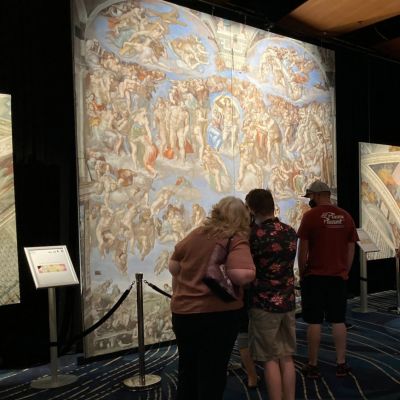New Zealand Arts ReviewReviews,
News and Commentary by John Daly-Peoples
Auckland exhibition of Michelangelo’s Sistine Chapel looks better than the original
MICHELANGELO – A Different View - Hunua Room, Level 1, Aotea Centre
The Sistine Chapel at the Vatican is home to one of the greatest artistic accomplishments in history. It was there in the early 16th century that Michelangelo created the brilliant religious frescoes on the ceiling telling the stories from Genesis. He also painted The Last Judgement on the altar wall, depicting the Second Coming and the Final Judgement.
While millions of viewers have visited the chapel in Rome each year it is not always the most pleasurable experience with the room crowded with hundreds of people anda constant babble of voices. Having to crane one’s neck to see the ceiling surrounded by milling people is not the ideal way to see the work.
Now a new photographic exhibition attempts to replicate the experience with large reproduction of the Michelangelo’s ceiling and The Last Judgement
The exhibition has used state-of-the-art technology to reproduce photographs taken of the artworks following recent restorations
The printing techniques used have been able to reproduce the colours, the details and brushstrokes, even compensating for the curved nature of some of the paintings
The reproduction 4.6 metres by 20 metres – about half the size of the actual ceiling but up close the images provide a new experience.
The image of the ceiling is laid out on the floor and adjacent to it is a viewing platform which provides a view which in many ways is better than the original. Even if you have seen the original this is a different experience as you can see the detail of the work and appreciate the overall design as well the juxtaposition of figures and colours.

Many of the smaller elements of the work which are hardly visible when standing in the chapel such as the small bronze-coloured medallions but these are clear now and add another level of complexity and understanding to the work.
For many the work will be a religious experience seeing the stories from the Bible brought to life on a grand scale. For others it will be an admiration of the originality and skill displayed by the artist along with an appreciation of the working conditions he faced in creating the works.

Michelangelo, The Last Judgement
On the Sistine Chapel ceiling he painted his complex telling the story of the Creation according to Genesis, the beginning of the world. Then in the Last Judgment he presents the end of the world when the godly are separated from the ungodly. Here the scene is presided over, not by the old, bearded god of the ceiling but by a youthful dynamic figure. Michelangelo also included a self-portrait – a flayed skin which is something of a metaphor of the artist who considered himself to have been eviscerated by the whole painterly journey.
The ceiling painting is a stunning example of trompe l’oeil with the painter creating an illusory architecture with marble putti supporting a cornice on whose regularly placed outcrops are stone seats on which, nude figures are seated along with images of major Prophets and Sibyls seated on monumental thrones .
Michelangelo, Delphic Sibyl
Michelangelo had a difficult task in reconciling the ideas of Renaissance Humanism with the theology of 16th century Christianity. This was because the Church emphasized Man as essentially sinful and flawed, while Michelangelo was focused on Man’s beauty and nobility. The two views were irreconcilable and led to later problems such as the nudes of the Last Judgment having drapery painted over their testicles after the artists death.
For Michelangelo it was the creation of the human body which was paramount. In his depiction of the creation of Adam it is not so much the creation of a man but the creation of a body and this awe in the beauty of the human body is repeated in many of the figures both naked and clothed
Prior to the Renaissance images of God were rare and generally symbolic. In the early Renaissance such image depicted a patriarchal God the Father as an old man, usually with a long beard. Michelangelo’s image of God saw him with almost human qualities. In the second scene, the Creator is fully defined and heroic and we even see a rear view of him with his buttocks visible through purple drapery.
Also included in the exhibition are images of the lower frescoes in the chapel. Often given less prominence these wall paintings by several artists including Botticelli, Perugino, Ghirlandio and Matteo da Lecce depict the Life of Moses and the Life of Christ. They were all completed in twenty-five years before Michelangelo began work on the ceiling.
They are impressive paintings but do not have the same power as those of the Michelangelo works Rather than just tell stories he attempted to create emotional responses through the power of gesture.
Many of these artists were showing off their draughting and painterly skills using the relatively new ideas of perspective with Perugino’s Christ Giving the Keys to St. Peter being a fine example. Michelangelo does not use these techniques instead using his knowledge of anatomy to create tactile human figure in three dimensions.
When one compares the naked torsos in The Disputation over Moses’ Body by Matteo da Lecce. with those of Michelangelo’s one can see his consummate understanding of the human figure.
Important to an understanding of the paingtings is the role that the Pope Julius II played in commissioning the works. He was a warrior pope and he chose his papal name not in honour of Pope Julius I but in emulation of Julius Caesar. He was one of the great pre reformation humanists seeing links between the Ancient Greeks and this can be seen in other works he commissioned by Raphael such as The School of Athens (also in the Vatican) being painted at the same time as Michelangelo was working on the Sistine ceiling
Like Julius the individuals faces portrayed are bold and dramatic and filled with energy. Compared to the figures in the lower frescoes these are strong personalities which speak of the need for militant Christians, not the softer versions of the lower frescoes.
Michelangelo’s inventiveness can be seen in the figures he creates. He has used the faces of ordinary people. He probably used the faces of people he saw in the streets or in the church not the stereotypes normally used. These figures are men and women who walked the streets of the sixteenth century Rome.
Michelangelo’s masterpiece combines the worlds of art, religion, science, and faith in a provocative and awe-inspiring work of art.











